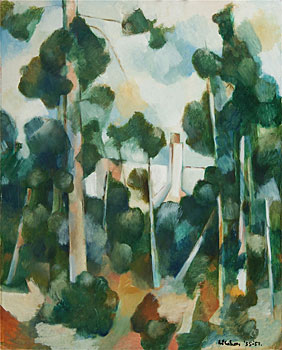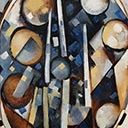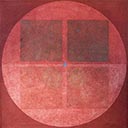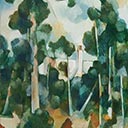House in the Trees
64.1 x 51.3 cm
est. $90,000 - 140,000
Provenance: Brenda Gamble Collection Private Collection, Auckland
Record number cm000390 Colin McCahon online catalogue www.mccahon.co.nz
Exhibited: McCahon Survey Exhibition, Auckland Art Gallery, 1972
This painting dates from the time when Colin McCahon and his family literally lived in a 'house in the trees', in the kauri bush above French Bay in Titirangi between 1953 and early 1960. Indeed the very first paintings he made when he came to Auckland were depictions of houses in the trees near the modest bach which the McCahons inhabited in Ottitori Road. A painting, now in Auckland Art Gallery, dated 1953, has a very similar title, House in trees, Titirangi (cm000487) and several others share the same subject matter but have different titles such as Kauri (unfinished) (1953, cm001408), which includes a depiction of the McCahons' own dwelling. McCahon told his friend John Caselberg in a letter dated November 30, 1953 (quoted in Peter Simpson, Colin McCahon The Titirangi Years 1953-1959, AUP, 2007, p. 25): '…am doing the bush, hard, must come to some solution of the domestic landscape before I can start using it in any way'. In fact he kept returning to the 'domestic landscape' (a phrase that is itself the title of several paintings) again and again over the next five years; it was a subject that he never seemed to tire of, or, to put it another way, never mastered entirely to his satisfaction. He soon moved away from what he called a too 'descriptive' approach to the subject - by which he meant too literal or realistic - frequently deforming and deconstructing the landscape in accordance with his understanding (or misunderstanding as some believe) of cubist principles, which were of great interest to him since his Australian visit in 1951.
As it happens, the present painting is one of the more 'descriptive' works of the period. The clouds and patches of blue sky are handled quite realistically; likewise the trees are readily identifiable as young kauri (or 'rickers' as they are known) with their tall slim trunks and foliage bunched along the branches, just as the chimney and roof line of the house are clearly recognisable through a gap in the vegetation. The 'portrait' format of the work emphasises the strong verticality of the trunks and chimney, varied by only occasional diagonals. The placement of dark against light (a standard McCahon procedure) is very deftly handled. There is little evidence here of the faceting or fracturing or fragmentation of the picture plane that occurs in so many of McCahon's paintings of this period. Why does he date the work 1955-57? Presumably because like a number of other works with a similar dating, it was an unfinished work that he returned to a couple of years later, perhaps when he was preparing for his exhibition Recent Oils at the Peter Webb Gallery in October 1957, his first solo show in Auckland. Since no exhibition catalogue of that show survives, this is only a surmise but would seem to explain the extended date on the work. The small scale landscapes of the Titirangi period have been rather overshadowed by the larger and more radical works McCahon moved on to later, but paintings such as this are felicitous and delightful in their own way - a frank celebration of looking and seeing - and are among the most angst-free and approachable works of his whole career. PETER SIMPSON





